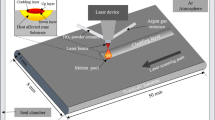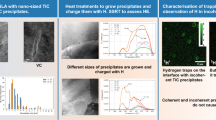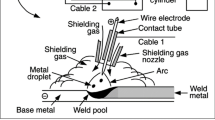Abstract
An investigation has been made of the nature and extent of chemical reactions between various liquid metals and a range of engineering-grade ceramics typically used as cutting tool inserts. Such possible reactions are relevant to chemical wear effects during metal cutting but also relate to liquid metal containment by ceramics and ceramic-metal joining. The experimental procedure has involved immersing pre-polished ceramic sections in liquid metals for controlled times with subsequent sectioning and examination of the reaction interface. The ceramics studied were two alumina-based materials and five silicon nitrides and sialons. The metals were pure iron, pure nickel and four iron-nickel alloys (a mild steel, a stainless steel and two nickel-based superalloys) and span a range of Fe-Ni compositions. The reaction rates of the alumina materials were found to be much lower than those of the silicon nitride-based materials and reflect the chemical stability of the Al-O bond array. Zirconia-toughened alumina showed little evidence of reaction with clean iron alloys but substantial attack by oxygen-containing iron-based materials was found resulting in the formation of iron-aluminium spinel reaction products. Al2O3-TiC/N exhibited preferential metal attack of the carbonitride phase with dissolution and/or replacement of the TiC/N dispersion. Within the silicon nitride-based group, ferrous alloys were found to be more damaging than mainly nickel alloys and silicon nitrides were more readily attacked than sialons. The difference in behaviour between the sialons and silicon nitrides is attributed to alumina additions in the former group of materials increasing resistance to attack by molten metals. A detailed mechanism of attack for these mixed-phase ceramics is proposed whereby a silicon concentration gradient is established from the crystalline ceramic phases, through the glassy binding phase, to the metal. The result is dissolution of the crystalline phase and an increase in volume fraction of the glassy binder at the metal-ceramic interface with concomitant progressive disruption of the ceramic microstructure.
Similar content being viewed by others
References
D. B. Binns,Trans. J. Brit. Ceram. Soc. 77 (1978) 1.
B. M. Kramer andN. P. Suh,J. Eng. Ind. 102 (1980) 303.
P. A. Dearnley,Surf. Eng. 1 (1985) 43.
W. B. Hillig, in “Tailoring Multiphase and Composite Ceramics” edited by R. E. Tressleret al. (Plenum Press, New York, 1986) p. 697.
A. Whitehead andT. F. Page,Ceram. Eng. Sci. Proc. 10 (1989) 1108.
W. M. Armstrong, A. C. D. Chaklader andJ. F. Clarke,J. Amer. Ceram. Soc. 45 (1962) 115.
K. H. Jack,J. Mater. Sci. 11 (1976) 1135.
J. A. Yeomans andT. F. Page,Wear 131 (1989) 163.
E. M. Trent, “Metal Cutting”, 2nd edn, (Butterworths, Guildford, UK, 1984) p. 29.
J. A. Yeomans, Ph.D. Thesis, University of Cambridge, (1986).
C. M. Levin, C. R. Robbins andH. F. McMurdie, Phase Diagrams for Ceramists (American Ceramic Society, Ohio, USA, 1964).
R. Barrett andT. F. Page, “Wear of Materials 1989” edited by K. C. Ludema (ASME, Ohio, USA, 1989) p. 441.
G. Derge, “Basic Open Hearth Steelmaking”, (AIMMPE, New York, 1964).
J. Kunze, P. O. Friedrich andK. Friedrich,J. Mater. Sci. Lett. 5 (1986) 815.
A. E. Pasto,J. Amer. Ceram. Soc. 67 (1984) C178.
M. J. Bennett andM. R. Houlton,J. Mater. Sci. 14 (1979) 184.
M. H. Lewis andR. J. Lumby,Powder Met. 26 (1983) 73.
J. Aucote andS. R. Foster,Mat. Sci. Technol. 2 (1986) 700.
Author information
Authors and Affiliations
Rights and permissions
About this article
Cite this article
Yeomans, J.A., Page, T.F. Studies of ceramic-liquid metal reaction interfaces. J Mater Sci 25, 2312–2320 (1990). https://doi.org/10.1007/BF00638021
Received:
Accepted:
Issue Date:
DOI: https://doi.org/10.1007/BF00638021




